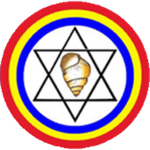Bundu dia Kongo
Bundu dia Kongo (Kikongo; literally "Gathering of Kongo"), known as BDK,[1] is a new religious movement with a political and cultural agenda that is associated with the Kongo ethnic group. It was founded in June 1969 by Ne Muanda Nsemi, who is the group's current leader, and is mainly based in the Kongo Central (Bas-Congo) province in the Democratic Republic of the Congo. The movement supports Kongo nationalism and the creation of an ethnically-Kongo state that would encompass parts of the modern-day Democratic Republic of the Congo, Angola, and the Republic of the Congo.
| Bundu dia Kongo | |
|---|---|
 Logo of Bundu dia Kongo | |
| Active | 1986 – present |
| Ideology | Kongo nationalism Separatism New religion |
| Leaders | Ne Muanda Nsemi |
| Area of operations | Kinshasa, DR Congo |
| Opponent(s) | |
Ideology
Bundu dia Kongo advocates the establishment of a federal state in Central Africa and the eradication of social and economic injustice imposed on the Kongo people by local governments. The movement also advocates the resistance to programmed destructuring of the historical consciousness of the Kongo people, their founding values and deep personality through a better knowledge of their spiritual heritage.
Clashes with the police
In 2002, police shot and killed 14 followers of Bundu dia Kongo in a demonstration.
In January and February 2007, the followers of Bundu dia Kongo demonstrated against alle in the provincial elections, which led to violent clashes with the police and the military in Matadi, Muanda, Boma and Songololo. The clashes resulted to the death of 134 people, mostly civilians but also several policemen. The movement also has a strong belief in their ancestors and consider Jesus Christ as a prophet. In late February and early March 2008, the followers of Bundu dia Kongo clashed with the police in and around Luozi and Seke-Banza. According to the police, the clashes resulted in the death of 25 people (22 of them in Luozi) and many wounded. Nsemi, who said that he had called for calm and a neutral investigation, alleged that the police had killed 80 people in Luozi and 40 in Seke-Banza.[2] Later, in May, corpses of 40 people were unearthed in five mass graves in Sumbi, in the territory of Seke-Banza.[3] Also a police car and several houses (including the meeting house of Bundu dia Kongo) were burned in Luozi and the nearby village of Lufuku.
Later in March 2008, the Congolese government banned Bundu dia Kongo.[4]
United Nations Mission in the Democratic Republic of Congo (MONUC) carried out a special inquiry into the events. The report[5] concludes that at least 100 people, mainly members of Bundu dia Kongo, were killed in the police operations in Bas-Congo. According to the report, the high death toll resulted from excessive use of force, when the police armed with AK-47s opened fire on BDK members, who were armed with sharp sticks, stones and kola nuts. A large number of bodies were dumped in rivers and mass graves in an attempt to conceal evidence. Also over 200 buildings were burned and private houses were looted by the police.
BDK upholds a presence in the western part of Congo and their idea of resisting all western influence has also resulted in attacks on for example Christian churches. In February 2017, new violent clashes between Congolese police and BDK activists was reported in Kimpese, resulting at least eight members of the group killed.[6]
On 17 May 2017, BDK followers freed their leader, Ne Muanda Nsemi, and 50 other inmates after attacking the Makala jail of Kinshasa, Democratic Republic of the Congo.[7]
In March 2020, police dispersed several BDK members in Kinshasa for defying a ban on gatherings of more than 20 people imposed to halt the spread of the coronavirus pandemic. Between 13 and 24 April, 2020, about 20 sect members and police were killed in three separate clashes on a key highway in the Kongo Central province. Eight people were killed, 35 injured, and 168 arrested, including Ne Muanda Nsemi, on a police raid on 24 April. Nsemi, who is about 70, was taken to hospital with a head injury before being handed over to prosecutors. Eight officers were seriously injured in the raid.[8]
References
- Pike, John. "Bundu dia Kongo (Kingdom of Kongo)". www.globalsecurity.org.
- "Police, DR Congo sect clash", Sapa-AFP (IOL), March 5, 2008.
- "40 corps exhumés de 5 fosses communes par la police à Sumbi", Radio Okapi, May 3, 2008
- "RDC: le gouvernement interdit une secte politico-religieuse" Archived May 21, 2011, at the Wayback Machine, AFP (Jeuneafrique.com), March 22, 2008 (in French).
- "Special Inquiry Into the Bas Congo Events of February and March 2008", MONUC Human Rights Division, 2008.
- "Congo police clash with sect, kill at least eight, activists say". Reuters. 3 February 2017.
- "BDK leader Ne Muanda Nsemi flees after DRC jailbreak". www.aljazeera.com. Retrieved 18 May 2017.
- "DR Congo police arrest sect leader after deadly raid". news.yahoo.com. Retrieved April 25, 2020.